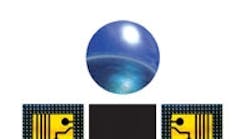Imagine devices imbedded in paint or at the bottom of a water cooler with the equivalent of human sensory capacity and intelligence. Imagine that these tiny silicon chips (Micro-Electro Mechanical Systems -- or MEMS for short) can process information and tell end users that the surrounding environment is too cold or too humid; there are noxious fumes; or that water is not suitable for human consumption. Also imagine that these chips can harvest energy from ambient sources (light, vibration, temperature gradients or motion), thus eliminating the need for hard wiring or batteries and making them extremely cost efficient and long lasting.
Siemens Building Technologies Inc., a Buffalo Grove, Ill.-based unit of German-based Siemens AG, is exploring and redefining MEMS technology -- the microchip technology that uses both the electrical and mechanical properties of silicon chips. Researcher Osman Ahmed heads the program.
View Past Technology Leaders
View The 2005 Winners
"What we have been thinking from a Building Systems perspective is that it would make sense to go beyond sensing and incorporate other pieces of the puzzle that we actually provide in a building system, i.e., the wireless communication, the intelligent microprocessor and power management," says Ahmed.
Siemens' vision is to put several pieces together in the same silicon, making it very cost effective and offering more functions, thus providing many more solutions compared with what can be done today, Ahmed says. And while scavenging for energy isn't commercially available for MEMS just yet, Ahmed hints at the potential in the future.
"If we have the power scavenging sources, then I think the next generation might be a hybrid system [lithium-ion battery and ambient power]. So you will be having a battery back up, but then you will be using power scavenging sources when they are feasible to apply. And that hybrid system might give you six to eight years of life [for the MEMS chips]."
As for manufacturing applications, Ahmed says there are three major categories. One is monitoring the plant environment (bio, chemical). Another is operational efficiency. And the third category is monitoring plant assets.
"But with Microsystems we can actually pinpoint precisely where is the problem, and in that way our response could be more cost effective," Ahmed says.
Adding to this, Ahmed says the Microsystem platform will enable users to customize the technology.
"So somebody may need toxins, somebody may need chemicals, somebody may need biosensors, somebody may just need environmental sensors. You can essentially create this platform and plug and play the sensor suite depending upon your application."



